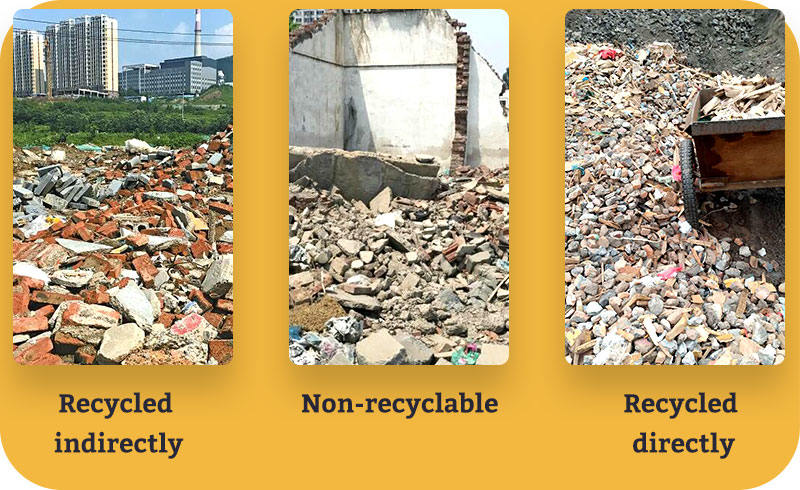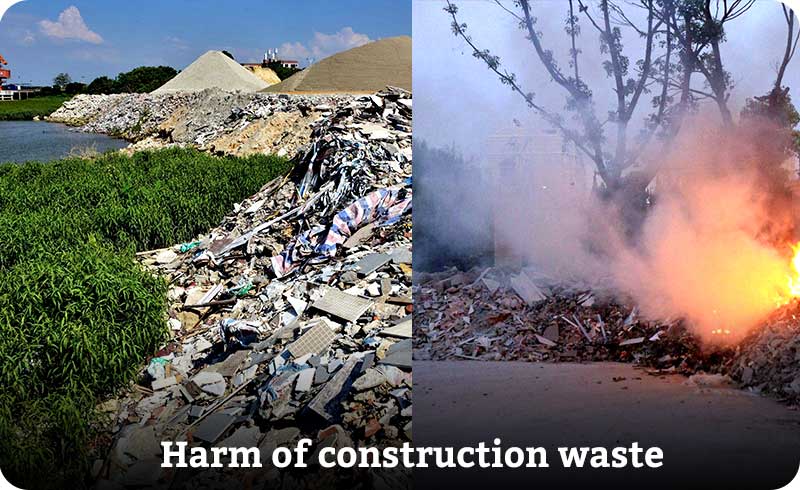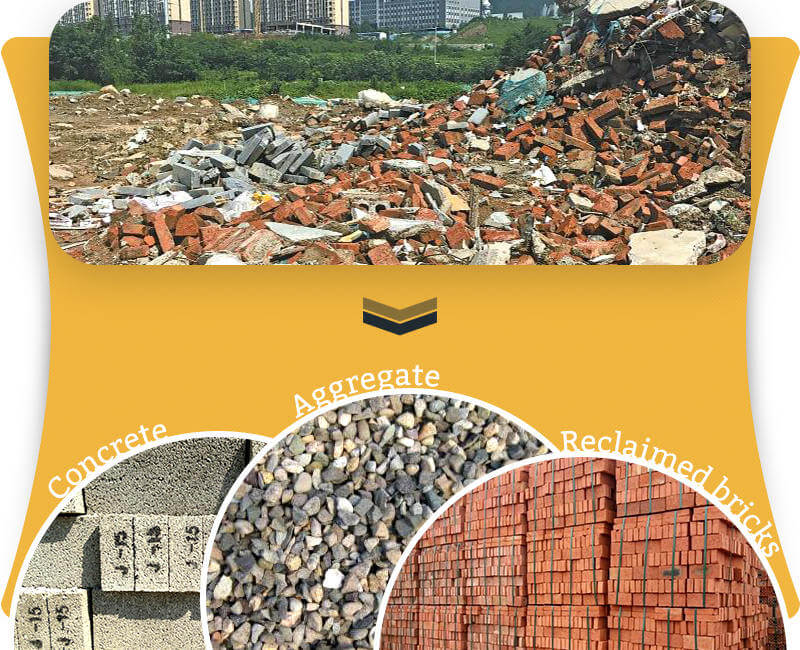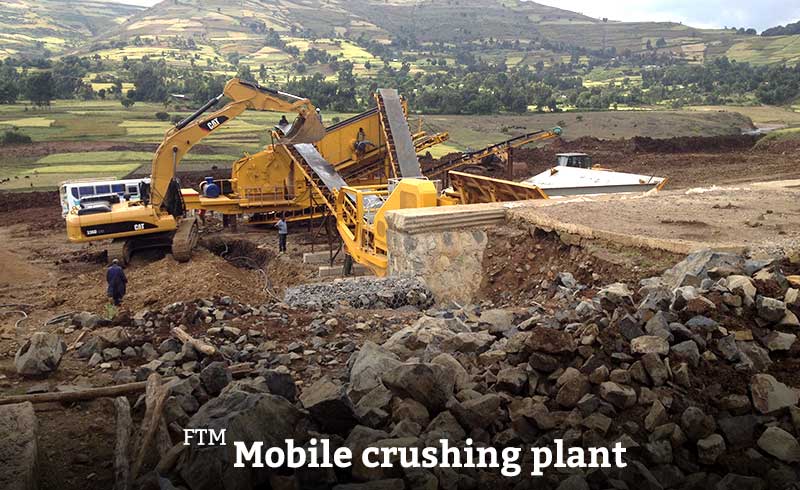
By: Ashley June 12, 2019 Last Updated :June 15, 2019
Currently, recycling the construction wast has become the common research topic for each country in the world. Most developed countries implement “Construction waste source reduction strategy”, which is to control the construction wast through the scientific construction waste management plan before forming the construction wast. Only disposing the construction wast in scientific methods can it be recycled. In many countries, the construction wast has been a new kind of resource, promoting the rise of emerging industries. The recycling rate of construction waste has reached 95% or even 100%.
Construction waste refers to construction materials caused by man-made or natural factors in the project, including the waste soil, spoil, silt, and discarded materials. These materials that bring about from disposal of construction waste are not helpful to the construction itself. They need to be well processed so that can achieve the ideal project construction. The construction is a while project, so every step must be considered.
As commonly stated, construction waste is a waste that is generated from the construction and demolition process of building products. Construction waste is produced in two processes: one is the construction process of building products. Another is the end of building products. Then, what construction waste material to recycle? Construction waste can be divided into three types according to its usability: one can be recycled directly like wood and bricks; another can be recycled indirectly like iron wore, rebar; the last is non-recyclable such as oil paint etc.
Three kinds of construction waste
During the process of stacking and landfilling for construction waste, the sewage that is infiltrated by the scouring of fermentation and rain, as well as the immersion of surface water and groundwater, will seriously pollute the surrounding surface water and groundwater.
Construction waste dumps pollute the surface water in many ways. The garbage is scattered in the ponds and ditches during transporting process. Leachate in the dumping ground flows into the surface water, and infiltrates into the aquifer.
Besides, the river and lake pits polluted by garbage infiltrated into the recharge aquifer,which causes deep pollution. Landfill leachate not only contains plenty of organic pollutants, but also has much metal and non-metallic pollutants, so the water quality is complex. It will be greatly harmful to human they drink such contaminated water.
With the constant development of city, more and more construction wast is stacked freely, which not only occupies land, but also pollutes environment or affects the air quality.
Under the action of temperature and moisture, some organic substances are decomposed and generate harmful gases because of stacking of construction waste. The waste gypsum contains a large amount of sulfate ions, which will be converted into hydrogen sulfide with rotten egg flavor under anaerobic conditions.
Waste paperboard and wood can dissolve lignin and tannic acid under anaerobic conditions and decompose to form volatile organic acids.This harmful gas will pollute the atmosphere when it is discharged into the air. Bacteria and dust in the garbage drift with the wind, and this will pollute the air; A small amount of combustible construction waste will produce toxic carcinogens in the process of incineration, causing secondary pollution to the air.
With the increasing of urban construction waste, the number of garbage dumps is also increasing, and its area is gradually expanding. Most of suburban garbage dumps are open-air.
After sunning and raining, the harmful substances in the garbage (including the polycyclic aromatic hydrocarbon structured materials released from paint, paint and asphalt in urban construction waste) penetrate into the soil through the landfill leachate, resulting in a series of physical, chemical and biological reactions. The harmful wast may be absorbed by plant roots or microorganisms, and this will pollutes the soil and reduce its quality.
In addition, under various external forces, smaller pieces of gravel will also enter the soil, change its composition,destroy its structure, and reduce its productivity. Furthermore, the content of heavy metals in urban construction waste is high, and chemical reactions will be occurred under the action of many factors, which results in high content of heavy metals in the soil.
Generally contaminated soils do not have the natural self-purification capacity, and it is difficult to reduce their pollution levels by diluting and diffusion, which must be addressed by a costly method of soil modification.
Pollution of the construction waste
Germany is the first country to recycle the construction wast. During the reconstruction of World War II, the recycling of construction waste not only reduced the cost of cleaning, but also greatly alleviated the contradiction between supply and demand of building materials.
Until the end of 1955, the construction wast reproduced about 11.5 million steres of waste brick aggregate, and using them to build 175 thousand of houses. 450 factories in 200 companies of Germany are now processing the construction waste, with an annual turnover of 2 billion.
In 1997, the amount of construction waste in Danish was about 3.4 million tons, accounting for about 25% of all kinds of garbage. The proportion of recycling the construction wast has been significantly increased since the he introduction of waste taxation.
Nowadays, about 90% construction wast is recycled. In just a few years, Denmark has established a joint system that is closely integrated with technical methods, scientific and organizational structures,and management tools to ensure control over the flowing of major wastes and recycling of most of the waste.
Japan is relatively scarce in resources, so it attaches great importance to the recycling of construction waste and regards it as a “construction by-product”. Since 1974, the building waste reuse Committee has been established in the building society, and obtaine a great deal of research results have been in recycled aggregates and recycled aggregate concrete.
In 1998, it is reported that the recycling rate in Tokyo construction waste has reached 56%. At present, in the disposal of the transformation of residential quarters, the local digestion of construction waste has been realized, and the economic effect is remarkable.
Disposal of the construction waste
The technology of recycling the construction waste was first started in Germany,and China is a little late, but the relevant technology ,in fact, has been gradually improved before the equipment is molded. So technically, domestic equipment is not inferior to foreign products.
Because the construction garbage stacking is concentrated, the site is limited, and the traffic is not very convenient, it is recommended to choose a mobile crusher to process the construction wast. FTM mobile crusher can help you sole this problem. This device can crush a variety of large chunks of materials.
The small footprint of the FTM mobile crusher can save a lot of infrastructure and relocation costs. It breaks the materials directly without removing them from site, resulting in a significant reduction in the cost of transporting. FTM mobile crusher can also be modified according to the actual site design, is very suitable for building waste crushing.
Construction waste is not real rubbish, but the “gold” that doesn’t be placed correctly. After sorting, removing or crushing the construction waste, most of them can be reused as a renewable resource.
Scrap steel bars, scrap wire, waste wires and other metals, can be reprocessed and manufactured into a variety of specifications of steel after sorting, concentrating, and re-furnacing; Scrap Bamboo wood can be used to make artificial wood; Brick, stone, concrete and other waste can be used for sand, masonry mortar, plaster mortar, etc.after crushing, can also be used in the production of paving brick, flower brick and other building materials products. All this makes the recycled construction waste has the outstanding advantages of high utilization rate, low production cost, wide use range, good environment and economic benefit.
FTM mobile crusher plant is a new crushing and screening equipment which specializes in the recycling and disposal of construction waste, and it integrates vibrating sieve, feeder, belt conveyor, different crushers. The development of this equipment help customers solve problems of high cost of transporting and installation, greatly reduces the duration of crushing.
The form of Integrated Unit installation eliminates the complex site installation operation of the split component and reduces the consumption of materials and working time. Reasonable and compact space layout of the unit increases the flexibility of site presence, as well as reduce transportation costs, improve its maneuverability and flexibility, greatly improve the adaptability of outdoor operations.
India, Indonesia, Malaysia, and Australia and other countries all have the FTM mobile crushing sites. If you are interested in our machine, welcome to contact with us and come to our factory for testing machine. We will use high-quality products and sincere service to win your satisfaction.
FTM mobile crushing site
Contact
Phone: 0086-0371-63313738 / 0086-18039114854
Address: Tanxiang Road, High-Tech Industrial Development Zone of Zhengzhou City, P. R. China.
E-mail:vip@sinoftm.com
Hot Products
Future Prospect
We would like to cooperate with customers all around the world, and welcome you sincerely !